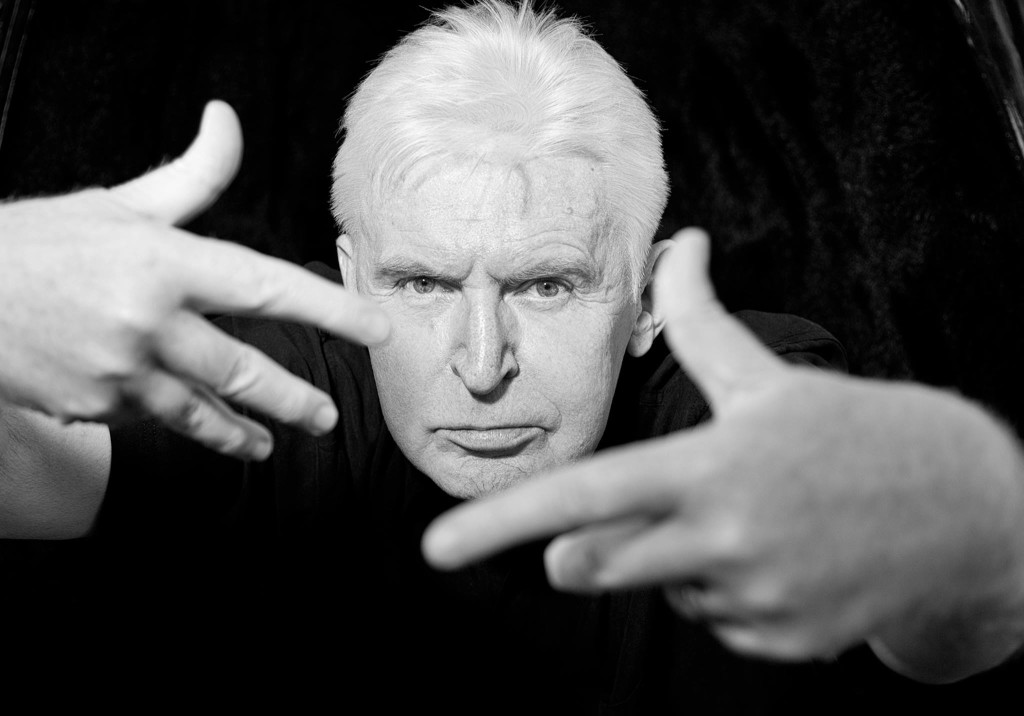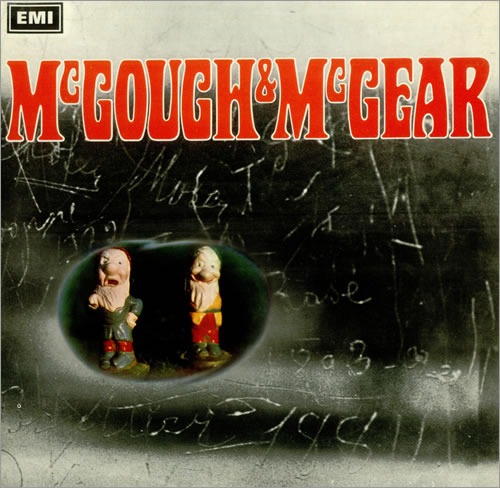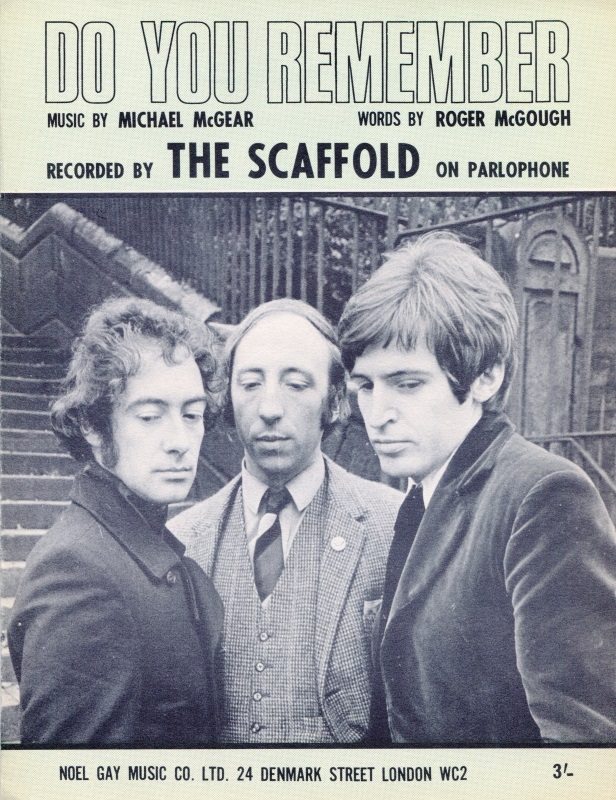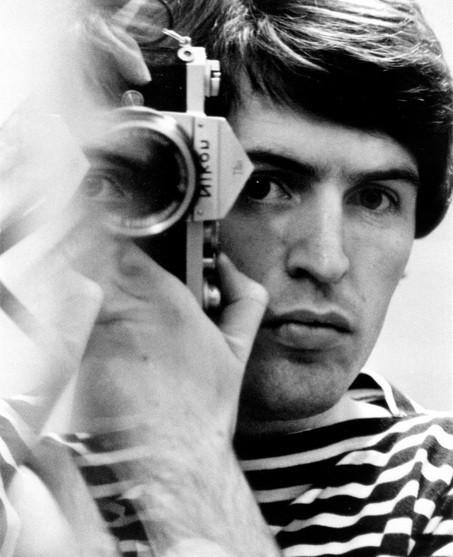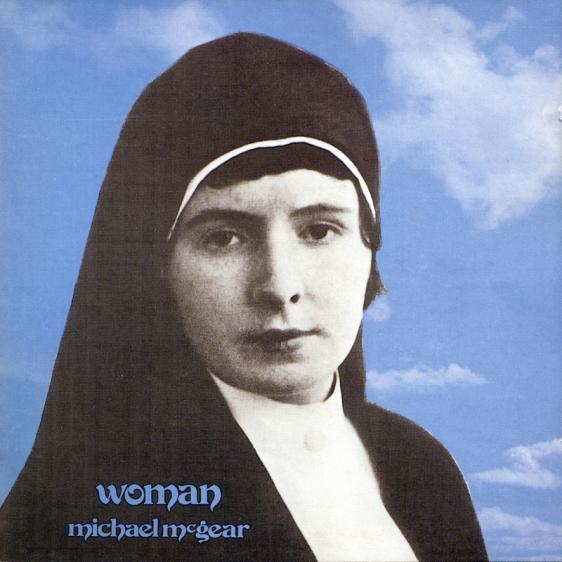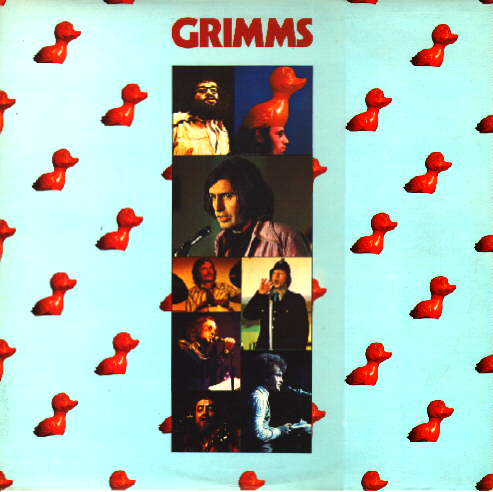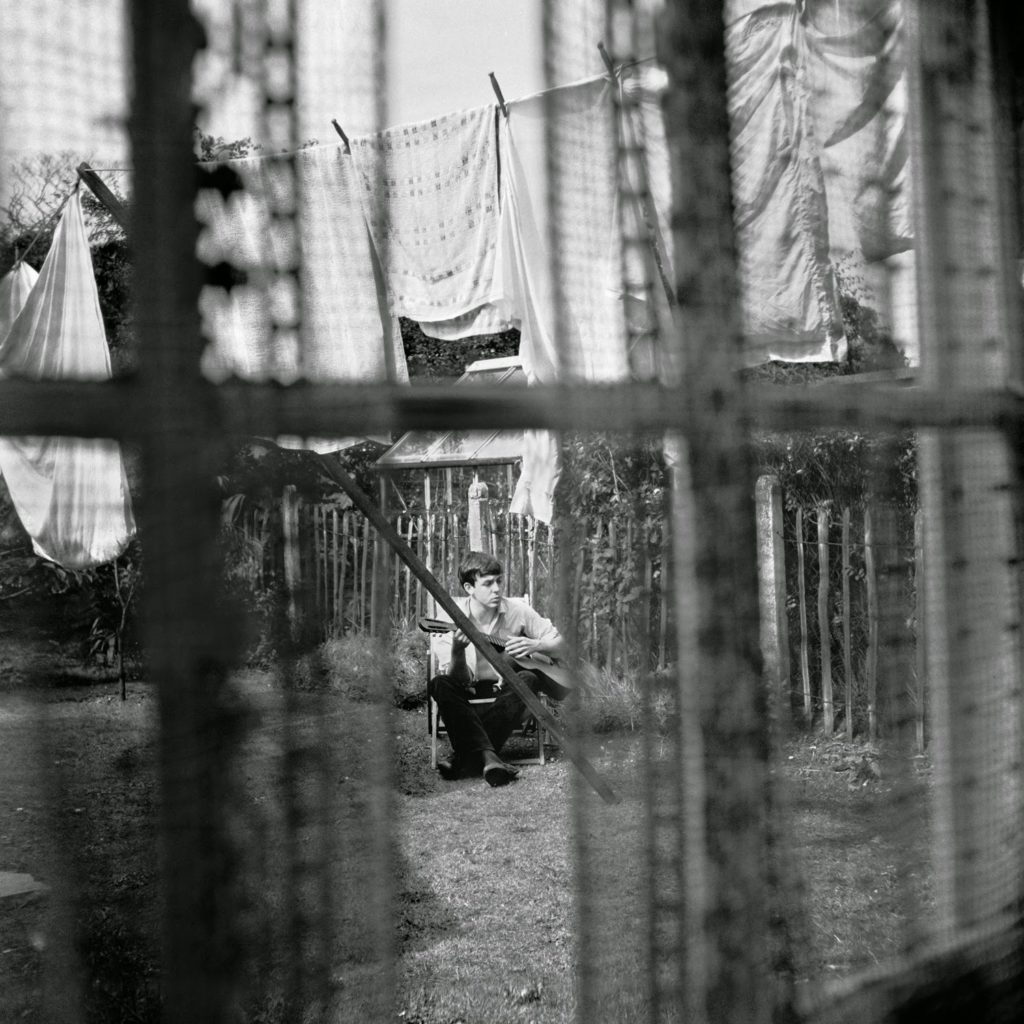Liverpudlian Mike ‘McGear’ McCartney is a chart topping singer, songwriter and photographer. As well as being one third of comedy-poets The Scaffold he was co-founder of super-group GRIMMS and successful solo artist.
However it’s the reissue of his legendary McGough and McGear album that draws us here. Recorded in 1967 and assisted in production by his brother Paul, musicians on the record included Jimi Hendrix, Graham Nash, Dave Mason and John Mayall.
Jason Barnard shares a Strange Brew with Mike.
The McGough and McGear album has received a deluxe reissue on Esoteric. You had an incredible cast of people who played on that wonderful album.
It was quite extraordinary when you think today of the line up. Obviously, our kid you would know, Jimi Hendrix with the Experience – Noel and Mitch. They came along, different days. Graham ‘Hollies CSNY’ Nash, Dave ‘Traffic’ Mason and his girlfriend Carol. Spencer Davis was there. Paul Samuel Smith from the Yardies, he went on to produce Cat Stevens and Carly Simon. He was an important part of this McGough McGear album. Gary ‘Walker Brothers’ Leeds. Viv Prince of The Pretty Things, he was the drummer that Keith Moon used to love, he looked up to Viv. ‘So Much In Love’ and the end of ‘Ex Art Student’ have that very Moony feel.
Mike Hart from The Roadrunners came down from Liverpool. John Mayall from The Bluesbreakers. George Zoot Bruno Money, was an integral part. On the floating sax at the end is William ‘Wib’ Bennett from the Royal Philharmonic in London. Andy Roberts was the main person behind all the poetry.
So if we got that line up in today’s marketplace the equivalent is people like Prince. Rihanna, Ed Sheeran, people like Elton John, if you got all of them that is the sort of line up that was there then. They just came along because they were mates or were passing through town. We started this album on June 18, our kid’s birthday. We won’t go into the fact that he had admitted on the very same day taking LSD. He was full of money. During the recording we became quite well known at Christmas, Scaffold’s ‘Thank You Very Much’ was number five or four in the charts. More people would be more amenable to coming in. They were contractually obligated and tied to the record companies but in the 60’s it was much better in terms of them saying ‘Sod off, we like doing this’. We weren’t a threat, comedy, poetry etc, it was not rock’n’roll. So when the rock n rollers came in, I was allowed to do all my songs there with the best in the world at that time.
What was the song writing process? Did you come with a rough idea and then flesh it out in the studio with jams?
We did the basic words that were McGough’s words, but then I thought of this idea of having all my favourite painters and then you start going. Jane Asher, who was our kid’s girlfriend then, she narrated it. So the whole album was very much loose and experimental. The best way to sum it up is live and loose. It was that sort of thing where we had no idea what we were doing until we got in, we just went for it. The majority of it was first takes. We just went for it and people were busy they’d come in and give us their time. Jimi Hendrix, come in and play your guitar, off you go. That’s what it was, very much a go for it album, don’t think about it do it.
I understand that Jimi Hendrix is on guitar on ‘Ex Art Student’.
That ending is the best ending, if you just let it go and sit back. A glass of wine or whatever pleases you, a cup of tea it doesn’t matter. Turn the lights down and where it fades down at that end and it goes into that Moony Viv Prince, I think Mitch Mitchell might have been with him. It’s a bit like the Scaffold track ‘Do The Albert’. As that fades down and then suddenly, this floating starts and you get Dave Mason on his sitar and then you get Wib Bennett with his beautiful flute. And then Jimi’s [mimics wah wah guitar]… those beautiful wah wah guitar noises like bubbles, rainbow bubbles coming in and that. You could just go on forever you could just because you could put on a loop tape and be in another world.
Fantastic, and I do recommend that everyone goes out and buys the reissue. You mentioned The Scaffold and there is a strong connection between McGough McGear and The Scaffold. What was the background of The Scaffold coming together?
I was a ladies hairdresser in Liverpool. One of them was Lewis Collins from The Professionals. He and I were juniors; he was younger than me at Andre Bernard Ladies Barbers in Liverpool. Jimmy Tarbuck had just left; he was going down to London to try to become a comedian. Lou and I were in there as juniors. I was passing up pins to the stylist Mike Weinblatt, he was a London boy, he said “You are arty Peter.” They had a Michael there, one of the senior staff was called Michael, so I couldn’t be called that so I went on the first name. My name is Peter Michael. So I became Peter, he said “You are an artistic, aren’t you Peter?” and I said “Why?” He said “Come down to The Hope Hall in Liverpool. It’s now the Everyman theatre. It’s a very important theatre, all the writers and the actors that came out of there was extraordinary.
But I went down with him to do these underground happenings and events and these two people were running it, John Gorman, a post office engineer and a poet called Roger McGough who was a teacher. Adrian Henri the painter, he was there as well. I just went to see it at first and they got me up and I tried to do a little sketch called “Old Folks”. I just read it from a piece of paper and the audience laughed. I thought “Ooh god, I can do this? They like it.” But we are collectively called The Liverpool One Fat Lady Non Electric Show. Then we got rid of a couple and three men emerged and we called ourselves Scaffold.
You were signed to Parlophone.
The first one for EMI Parlophone was ‘2 Day’s Monday’. The number ‘2 Day’s Monday’, coupled with number ‘3 Blind Jellyfish’. Then you get to the letter U, ‘Thank U Very Much. Who started text speak Jason?
It wasn’t Slade, it was actually The Scaffold.
Thank you. I did all that, yes. I am responsible for the world’s mess!
You were produced by George Martin.
There was an album in our house at Liverpool, Forthlin Road. It was called ‘Songs For Swinging Sellars’, which is Peter Sellars. We used to listen to this comedy album, which Peter Sellars did mainly sketches and a few little songs. It was a magic album and it was produced by a gentleman called George Martin. Then when our kid went into his rock ‘n roll business he was produced by George. That was a strange thing because George was comedy but obviously when it came to us doing a record the only one we wanted was the best man in comedy in Britain, George Martin. So we chose him and he did this beautiful ‘3 Blind Jellyfish’ and ‘2 Days Monday’. You can hear the orchestration on ‘3 Blind Jellyfish’. Think of some of our kid’s tracks like ‘Eleanor Rigby’ and listen to these similarities. That has always fascinated me because which one was first?!
George was a gentleman, lovely man, he was very professional. He was very good at his craft. So we went with him and I think it was just for that one, it might have been ‘Good Night Batman’ as well, I can’t remember.
I said to my wife that you wrote ‘Thank U Very Much’. She was absolutely flabbergasted because everybody knows that song.
It is like ‘Lily the Pink’ that has now has gone into history. It is now judged to be like a folk song and is now been taught in school. It is now forever in the British culture. Do you know how ‘Thank You Very Much’ came about?
Please tell me.
I was living up here in the Wirral, the Beverly Hills of Liverpool! Our kid lived in London with his pop group and he sent up for one birthday, this box. I opened it and there was a beautiful leather box. Etched into that was Nikon. Inside there in purple velvet was a Nikon F camera, it is the Rolls-Royce of cameras. Absolute magic. I was a photographer. I did all my early stuff, mostly on a Rollei Magic camera. Our kid and his group and Gene Vincent live at the Cavern, Jerry Lee Lewis, Little Richard when they came through Liverpool, Scaffold etc. To have suddenly the Rolls-Royce of cameras as a pressie was such a shock and a joy.
So I decided to ring our kid down in London. What happened with our kid was, this group that he was in, you wouldn’t have heard about them! They were good and getting big in London. So when anybody rang him, he wouldn’t say anything. He would let them talk and then if they were dodgy he would become a Chinese takeaway or restaurant cleaning or anything. He would just put them off. That was his trick, you always talked first. So I’m waiting for him to answer and the phone is ringing for a long time. Suddenly this tune pops into my head while the phone was still ringing. When I was just about to put it down, he picks it up and suddenly there was silence. So I said, “Thank you very much for the Nikon camera, thank you very much, thank you very, very much.” He said “You got it.” And I said “Yes I got it, fantastic. What a present it is so great, thanks a lot, thank you very much, you know, it is a pleasure ta raa.” Then I put the phone down and started humming the tune. We use that at the end of the Scaffold shows to thank the people for coming.
1968 was a really big year. Not only did you have ‘Thank U Very Much’, McGough and McGear, and then had a monster song. You mentioned ‘Lily the Pink’ is now on the curriculum.
Yes, the great thing is when you think “What have you done in your life? What have you contributed to society?” I’m not a brain surgeon, I haven’t invented anything extraordinary. The bottom line is that we made people happy. That to me is all I want. If people smile, hear your name and listen to your records.
Mike Vickers from Manfred Mann organised the session for ‘Lily the Pink’. Scaffold don’t play instruments, so we had to have the best session people in London and they would just come and whoever produced would get them. Norrie Paramore produced, so he and Mike Vickers got all the musos. I remember saying to Mike “What the hell is he doing there, the bass player.” He said “It’s just a job.” I said “He is Jack Bruce from Cream. I don’t believe this.” I went out there and I said “Hello Jack” “Oh hello Mike. Alright son, is everything okay” I said “Yes, it’s good. Now, listen Jack for this song, you play whatever you want.” I had to whisper it to him because you couldn’t let the other men do that, they had to follow the dots. He said “Aye Mike. I have been looking at the dots myself and to tell you the truth I think the best thing of this song (sings rhythm)” and that is exactly what he did. The can lad on it was a young man called Tim Rice, he was the coffee boy, the gofer. When you listen to this now, wait until it gets to ‘Jennifer Eccles’ verse. I rang Graham Nash who is on the whole McGough and McGear album. He had just had number one with ‘Jennifer Eccles’ and I rang him. I said “Grah listen, could you come to Abbey Road, we are taking the piss out of ‘Jennifer Eccles’ on this track we are doing. Can you sing it?” He said “Of course, Michael” So he comes along, listen to that verse it is so Graham.
The whole reason why we did it was to make a thud, thud, thud to get people dancing. At the end of the recording Norrie Paramor turned around and said “Mike, what do you think?” This was unusual because he is a producer, he is the boss. In fact Tim Rice is his book says “Norrie Paramore produced Lily the Pink, sorry Mike McGear produced Lily the Pink.” I was into listening to our kid’s stuff at Abbey Road, coming along to hear all the stuff they did, and particularly that period was the Pepper album. I was there all the time listening to all the tricks they got up to. I was really into it but not being a muso all I could hear the stuff in my head. I was sure I had to have a boom, boom, boom. At the end he said “What do you think Mike?” I said “That’s good, it’s nearly there. The whole reason we did it, do you remember was the boom, boom, boom. We get back up and we said to the engineer “Can we have more of the bass drum please.” He said “No, that’s it. We have put so much in this record that it is all over done. There isn’t any tracks” I said “Could you bounce some of the tracks now and leave me one free track? And he said “Not now. I will do it tomorrow. I went in the next day in my overcoat, it was cold. It was on Abbey Road the first one on the left of the three. One was the big one for “All You Need is Love”. Two was the one with the one you see on film and telly where we recorded most of our stuff. Three was Pink Floyd’s thing but they weren’t there that day. I went in and and I put my overcoat on top of Ringo’s bass drum and got the thud I wanted. This song has this lunatic talking to you. That is me banging all the way through.
You Graham Nash and Lesley Duncan did backing vocals on Donovan’s “Happiness Runs”.
That is right we did and it is a lovely peaceful little record. Yes I remember (sings) “Happiness runs, happiness runs”. I haven’t heard that in 50 years. Lovely lad Donovan.
Did you know him quite well?
He was around. When he first came on telly, we completely missed him because he was like a British Dylan, the same gob iron around his neck, the same guitar. But then his music started to change, it started to get interesting. He was such a nice man when you met him. He then started to evolve from those influences. That was why I was disappointed with Oasis. At the start, they were very Beatley and good. You thought “They can’t go on like that. And they did!”
Absolutely and Donovan saw him on tour recently. Mike, you had a really good solo career in the 70s and one of the things I noticed is that you had a great backing band.
They were friends really. Because we couldn’t play musical instrument, we were dependent on session men in the recording studio. They were all brilliant musicians but they just played the dots and went on. They were businessmen, they were genius musicians but we never went to the pub with them after because they wanted to be home with their families. It was purely a job so slowly we got round us a nucleus of people and we became friends. We’d go and see them in London, Zoot Money, Paul Samuel Smith from the Yardies, these people were mates. Andy Roberts, the guitar player, used to back us many, many times. Slowly all these people, John Mayall, Spencer Davis etc, you’d see them in the clubs and then you start working with them.
On ‘Woman’ I said to them, “Look lads, I have done the commercial stuff”, Thank U Very Much. I wrote that for Scaffold, then ‘Lily the Pink’, a big number one and so “I would like to do something different now.” So I got all these musos around me, I think the Neil Innes was in there at the beginning. I said “Look lads, can you come up North and we will go into Strawberry Studios, 10CCs studio” That is where we did the majority of it. “I have got these songs and see what happens.” I put a few up in my house here and we drove to Strawberry Studios every day. That album evolved and is completely nothing to do with my Scaffold albums. Like the McGough and McGear album we consciously know what we were, we know we are Scaffold. We are humorous and it is a fun band.
Like Brian Epstein once said to me, the early days of The Beatles “Do you want me to make you a pop star?” I said “No, I want to be a Scaffold first, at universities, theatres to get into the business.” Our kid is doing rather well. To follow that would be stupid. Later I’d established myself and so I’d wanted to do something different. So I recorded the ‘Woman’ album. I was still contractually obliged to EMI Parlophone so I finished the album. I took it down to London and went to Manchester Square EMI. It was so different to the Scaffold. I played it to all the bosses there and they sat there for the whole thing and you could see that they just didn’t get it. But they listened patiently, at least they did that, and at the end, I was just waiting for the big round of applause and “That is fantastic Mike, yes it is very nice”. I was walking down the corridor and I was with the boss of EMI Records, and I said “What do you think?” He said “Ah, yeah, very good Mike but when are you going to give me another ‘Lily the Pink’? So I thought “You’re not the one for me.” So I let other people hear it. That is why I got out of EMI Parlophone and went to Island and Warners etc. They understood these people, they were more into music. It was a fascinating departure, it is a lovely thing to do that.
And the title track is a really lovely song.
Did you ever saw a series, Danny Baker’s life story, ‘Cradle to Grave’. If you ever see it on the television or you get it on DVD, look at the last episode and you see Danny Baker’s parents and his mum having an affair with this bloke, is she going to leave the dad who is played by Peter Kay in the TV series. This poignant thing is where she is going to this wedding, she is moving all the guest tags around the table and my song, ‘Woman’ comes on. I wrote to Peter Kay and said “Listen, my song is the last episode.” He sent me back an email saying “I know, I heard it and it is very poignant, very sad. Have your hanky when you are listening to it.” I did the Danny Baker radio show. He is right into his music and he brings us the ‘Woman’ album from underneath and said “This is the Woman album. It is fantastic. I love the cover.” I said “Yeah, that is my mum.” He said “Pardon” I said “Yes, that is my mum, everyone thinks that she is a nun. She was a nurse and that is on old picture of her as a nurse.” He said “That’s your mother?” He couldn’t believe it. He said “I’ve had that for forty odd years and that is the first time I’ve heard the story of that is your mother.” So it is a nice peaceful track, ‘Woman’.
The album deserves a reissue. I’m not sure it is available at the minute.
No I don’t think it is. People are seriously talking about it after the success of this McGough and McGear album. People are saying that is amazing today. It’s come full cycle. It’s so loose and free, live and the people are getting excited and actually liking the thing.
Next Mike, you went into GRIMMS.
Do you know what GRIMMS is? G for Gorman, R for Roberts, I for Innes, McGough and McGear, S for Stanshell. You are getting all the secrets from me today Jason!
Quite a bit of comedy in music super-group really.
Such a joy to do, it was such a fascinating concept and the original GRIMMS was the one I was in and proud of. Then it became too big, it got too many poets, too many singers, too many comedians and I had to leave. Helped with the Brian Patten, the poet coming for me on a bus drunk out of his head. The original GRIMMS was magic. We’d have people like the Average White Band and the Dundee Horns, who were on Scaffold’s ‘Fresh Liver’. They would come along into the GRIMMS gigs and help us with the brass and things like that. It was a really magical evening to put those two groups in the same room together, it was just a magical evening. Neil Innes had these gigantic shoes, platform shoes. Have you ever seen Elton John in Tommy? Did you remember him when he had a cap and his glasses? And he comes on in giant boots, pinball wizard do you remember that? He nicked it from Neil Innes. The whole place would go dark and there was a little light on the microphone in the front and slowly you could see somebody from the back slowly coming on because it is very hard to walk in those big boots. He was holding a guitar and comes right to the microphone in his giant boots and he goes to sing and the microphone is down there and somebody has to come and put the microphone up. But that is it, the big walk down. He finally gets the mic on and says “Ladies and gentlemen, a short blues” and he goes on his guitar [sings blues riff] and walks off!
Then again there was Neil singing, “How Sweet to be an Idiot” with a yellow duck on his head. He had a big one and he chop the bottom off it, he was going bald and stuck it on his head and sang dead serious, “how sweet to be an idiot”. Then Viv Stanshall came on and he was a genius, he was so good. Certain people are giants in the music world and comedy. Viv was such a unique man, ginger hair, big beard. If him and Moony got together, be careful! Keep out the way they were dynamic.
Mike I have to confess I have played your version ‘Sea Breezes’ by Roxy Music before on my podcast. I really like it. It was on your McGear album.
It was the opening track. Our kid chose that. I said “I don’t know it.” He said “Listen, I’ve got a way of doing it, it is different to Bryan’s.” I said “Well, I love Roxy music…” He said “I have it good way of doing it.” Brian was very happy, contacted us and said he loved my version of his song, which is a compliment.
The guitars are really good, who was that?
I think that would be Denny Laine and might be our kid because he did a lot of multi-instruments. It might be Jimmy McCulloch in their as well.
What led up to the recording of the album? You wanted to record again.
It was our kid making the mistake of saying “What are you doing?” I was in between things and I said “Nothing.” He said “Shall we try some music?” and I said “Yes, I do the comedy stuff but yeah I’ll have a go.” I went down to his house in London. We sat around and we came up with this song called “Leave It” coupled with “Sweet Baby” which we did here in this house. That’s how it started. It went down so well with these people in America, the Eastmans there. They were getting us a record deal and playing it to people who said “Hold on, what, you are stopping there? You should do an album.” Paul said, “What are you like on time?” I said “I am doing nothing.” He said “Well I’ve got a period that I can do. Shall we go for an album in Strawberry and come up North.” He has a house up here as well. So we used a setup every day in our car, taking our pate butties with us and little mixture drinks and just go to work in Strawberry, every day.
‘Leave It’ was a big hit.
It was yes, it went across Europe and America. We brought it out at the time of the album. I think it went out first and then we followed up with the album. But they always played that one when we went to America and Europe did telly and that sort of thing.
I did “Leave It” on Top of the Pops and in the room next to me was Brian Ferry. It came to the thing and I said look to the BBC people. There we used to be an advert the Sandam and Port Man. He had this big cloak on and black hat, very stylish. I said “I want to be the Sandam and Port Man. I’ve got the hat, it is a beautiful velvet type of hat and I need the coat.” The BBC said “Look, we haven’t got one in Wood Lane television centre but we are trying for you. We are trying to get it somewhere else.” Just before transmission, just before it went out I said “Where’s my coat?” I said “Really, I can’t do it without the coat, just to go in there with a hat. It will look stupid. As they said “Hold on, hold on here it is.” I said “Let’s, get it on.” They said “Mike you are going to love where it came from.” I said, “Let’s get it on. The show is going to start in a second. They said “Mike, you are going to love.. “ I said “Why?” They said “We got it from Elstree Film Studios.” I said “And, so.” They said “Look in the label. So I looked in the label, just before I put it on and went in front at the Top of the Pops and sang “Leave it”. There inside the label was “Christopher Lee”, it was Dracula’s coat.
Do you like the false end there? DJs when it first came out and didn’t know, it came back and suddenly it would blow their heads off. So they hated it until they got used to it, that lovely false tab on the end and I like that.
One of my favourites from the album is ‘The Man Who Found God on the Moon’. What was the genesis of that song?
That was lovely. I had these ideas. We got into Strawberry and our kid said “What are we doing today?” I said “Well, I don’t know.” He said “Shall we go home?” I said “I’ve got these words and I will work on them here. You see how that goes down there. I just think it will all fit together.” Just like on his ‘Band on the Run’ they all flow into each other and I like that. I always like light and shade, that is me and that is why I love Pepper and things like that and the band and the way they flow in. That first one was just a drive that I had from London to Liverpool and I was going along the motorway and these balloons were just floating along. Sunset and these rockets went off on this one trip home from London to Liverpool.
Then the next ‘Make Me Happy’ bit came from when I was in London in a recording studio waiting to go. I was in reception and this little girl popped her head round the door, she was selling stuff for Hari Krishna. Her name was Annette. I said, “Are you all right love?” “Yes, I’m fine.” she said “Would you like some flowers.” I said “Yes, I’ll buy those. What are you doing?” She said “I love doing this. I am Hari Krishna.” All these things just fitted in.
Then ‘The man got on the moon’ bit. I was watching that on telly live in the early hours of the morning. I had this tape recorder taping it and I found that his thing lands on the moon. I found out that bit where he was saying his bit live from the moon. Buzz Aldrin when he went up, it was so extraordinary. Can you imagine being up for the first time and floated above the earth like Bowie but you are a real man down from Earth up in heaven and you are looking down. It was such a profound experience for him that he found God. The man who found God on the moon. He saw the enormity of it all and became Christian.
I think I can hear Denny and Paul on backing vocals.
It is and Lin I think is in there as well. Our kid did that floaty bit, that’s very him. The whole thing was a magic track. When you put all the bits together, it just goes beautifully flows up and down and it just has a lovely feel to it.
“Liverpool Lou” was another massive hit for The Scaffold. That is linked with the recording of the McGear album.
It was. The BBC telly wanted The Scaffold to do a sketch with the actress, Rita Tushingham and Derek Guyler. They said “Can you sing the song for us? I couldn’t come up with a song. I was working with our kid and Wings in Strawberry and said “Have you got any ideas for a Scaffold song? I’m doing this telly.” He said “Oh, you wanna do Liverpool Lou.” I said “No, it is too folky, too Spinners.” He said “No, just listen to it.” It was very old and had been around for centuries in Liverpool. I had forgotten how it went and certainly didn’t know the words. I said to BBC telly people “Could you get me a song called Liverpool Lou?” They sent me two versions. One was by Dominic Beehan and the other was by Delaney and Bonnie. Scaffold tried to trad arrange ‘Liverpool Lou’ but Dominic Beehan had got to it before us and copyrighted it. He got all the writing credits and all of the money for Liverpool Lou. The other version by Delaney and Bonnie was absolute magic. Our kid heard those two opposites and said “You want to go in the middle there.” He did it, he made that song. That is just Wings with in the middle of ‘Liverpool Lou’, a 10CC gizmo. That’s the weird sound in the middle.
The Godley and Creme invention.
That’s right. It’s hard to play but I think our kid played it. Norm Yardley does the gob iron on Liverpool Lou, I was with him the other night. Nice track.
About 10 years ago Paul released the ‘Chaos and Creation in the Backyard’ album. The cover was one of the evocative photos that you did in the early 60s. For me it’s the composition of the photo that makes it, taking it behind the window frames.
It’s through me mum’s net curtains. She made them. She died when we were in Forthlin Road when I was 12 years of age. They are very important to me and our family. So my mum had died and there’s our kid sitting on the deck chair in our back garden with his guitar. He used to get lost in his guitar and there he is, miles away, sitting on a deck chair with the washing above his head. It’s such a lovely picture. I took it through the gap in the curtains.
In fact years later, James, our kid’s son. He’s a great musician and singer. He was up and said “Uncle Mike, can I see your’s and dad’s old house?” So I took him and there is the photograph on the wall. They’d put a deck chair in the yard and the washing on the line so you can look out and imagine our kid in the deck chair. I said to the guy running the house “Have you got a guitar?” He said “It’s an old one upstairs. It’s all out of tune.” Eventually he brought it down. I said “Here you are James. Look at the picture. See the way he’s holding it and looking.” You go be your dad.” So I sent him outside and took his picture, exactly the same way all those years later. I gave it to him and our kid as a present, the two of them together.
It sounds like the photos you took were key to the National Trust who own the house.
It is National Trust. When you get in you’re not allowed to take photos. The logic behind it is that the photographs were given to the National Trust and that’s the only place you should see it. I came across new ones last year, so I said “It’s the same deal. Nobody can see them except in Forthlin Road.” They are replacing about 10 and they’re doing some new publicity. I think I have allowed two out. That is a very special place for us because we lost our mum there. It’s very personal to us. It’s our little world. That’s why our kid chose it for his album. It’s just a lovely feel.
How do people find out about your photography, books and music?
I do Twitter a lot and Facebook. Soon you’ll hear more about my website. I’m just busy, that’s going to be rectified soon. You’re going to be able to see the stuff I’ve done and buy some of it.
What’s next for you?
I’m working on a book, ‘Mike McCartney’s People’. I’m now 72 and met many people over the years. There’s some interesting shots. I’ve also got a cartoon called The Weirdos. I did them originally in the late 60s and got letters back saying they were too weird, “We can’t use them.” I thought now could be the time for people to see The Weirdos.
I’m organising an exhibition with some people to stop elephants being killed. There are now people being killed trying to save elephants. A poor man was shot down in a helicopter. So I’m doing lots of things.
Thank you so much for your time. It’s been an honour and privilege to speak to you.
Brilliant. As long as I get a case of strange brew, that will do me!
I will get a case in the post! Thank you.
You can keep posted on Mike’s activities at:
The McGough and McGear reissue is out now through Cherry Red.
A podcast with this full interview and tracks featured here is also available:
Mike McGear McCartney
Copyright © Jason Barnard and Mike McCartney, 2016. All Rights Reserved. No part of this article may be reproduced or transmitted in any form or by any means, without prior permission from the author.
